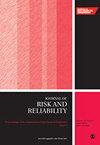基于扩展 FMECA 信息的可维护性测试样本分配方法
IF 1.8
4区 工程技术
Q3 ENGINEERING, INDUSTRIAL
Proceedings of the Institution of Mechanical Engineers Part O-Journal of Risk and Reliability
Pub Date : 2024-07-23
DOI:10.1177/1748006x241260997
引用次数: 0
摘要
为确保军事装备可维护性验证结果的准确性,针对目前试验样本分配方法中影响因素相对片面、权重主观的问题,提出了一种基于扩展失效模式、效应和临界分析(FMECA)信息的可维护性试验样本分配方法。从故障发生特征、故障影响和测试经济性三个方面分析和确定影响因素。提出了一种基于改进 LeaderRank 的故障传播强度计算方法,并将其引入 FMECA 进行扩展。提出利用 CRITIC 方法确定影响因素的客观权重,根据影响因素的相对重要性确定主观权重,引入博弈均衡法权衡确定组合权重,然后完成样本分配。最后,通过实例说明,该方法确定的影响因素更全面,权重结果更科学,样本结构更合理。本文章由计算机程序翻译,如有差异,请以英文原文为准。
Sample allocation method for maintainability test based on extended FMECA information
To ensure the accuracy of military equipment maintainability verification results, a sample allocation method for maintainability test based on extended failure mode, effects and criticality analysis (FMECA) information is proposed to address the problem that the influence factors are relatively one-sided and the weighting is subjective in the current test sample allocation method. The influence factors are analyzed and determined from three aspects: the fault occurrence characteristics, fault impact, and test economy. A method for calculating the fault propagation intensity based on the improved LeaderRank is proposed, which is introduced into the FMECA for expansion. It is proposed to use the CRITIC method to determine the objective weights of the influence factors, determine the subjective weights based on the relative importance of the influence factors, introduce game equilibrium to weigh and determine the combination weights, and then complete the sample allocation. Finally, an example showed that the influence factors determined by this method are more comprehensive, the weight results are more scientific, and the sample structure is more reasonable.
求助全文
通过发布文献求助,成功后即可免费获取论文全文。
去求助
来源期刊

Proceedings of the Institution of Mechanical Engineers Part O-Journal of Risk and Reliability
ENGINEERING, MULTIDISCIPLINARY-ENGINEERING, INDUSTRIAL
CiteScore
4.50
自引率
19.00%
发文量
81
审稿时长
6-12 weeks
期刊介绍:
The Journal of Risk and Reliability is for researchers and practitioners who are involved in the field of risk analysis and reliability engineering. The remit of the Journal covers concepts, theories, principles, approaches, methods and models for the proper understanding, assessment, characterisation and management of the risk and reliability of engineering systems. The journal welcomes papers which are based on mathematical and probabilistic analysis, simulation and/or optimisation, as well as works highlighting conceptual and managerial issues. Papers that provide perspectives on current practices and methods, and how to improve these, are also welcome
 求助内容:
求助内容: 应助结果提醒方式:
应助结果提醒方式:


